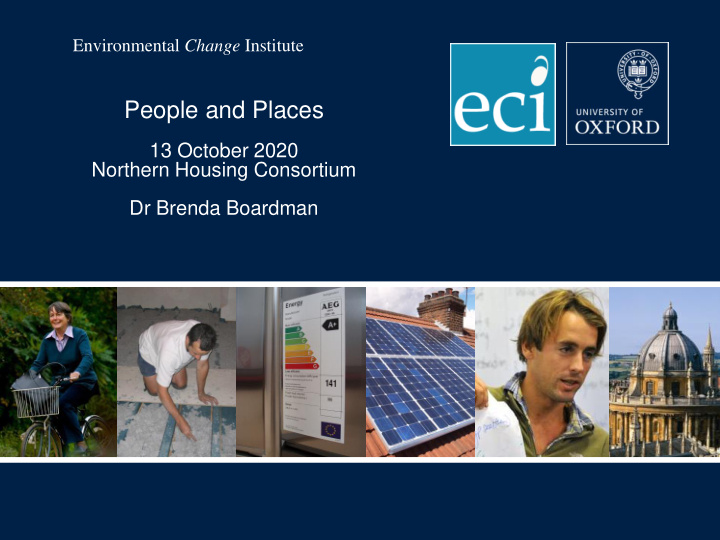



Environmental Change Institute People and Places 13 October 2020 Northern Housing Consortium Dr Brenda Boardman
Learning from fuel poverty Renting Owning Running costs More income, lower fuel prices Capital Landlord Grants expenditure responsible Capital expenditure crucial – from others Not the responsibility of the fuel poor
Lesson for travel poverty No car Car owner Running costs Cheap bus fares ? Capital Local facilities Get efficient car? expenditure Electric bikes No car and poor = travel less, employment difficult, rely on expensive, infrequent (?) buses Capital expenditure crucial – from others Not the responsibility of the travel poor
Who is travel poor? England 2018: o 24% of households with no car o 50% of households in social housing do not own a car o 25% of those aged 17+ do not have a driving licence o 2 nd adult in a car-owning household o Poor rural households travel half the distance of better-off rural households o Car-owning poor households = budget under stress
How to make a 15-minute neighbourhood o Main facilities within 15 mins walk of your home (< 1 mile) o Facilities, to be defined. Access to o cash o hair cut o mobile library, vet and doctor o primary school o buy nails and a newspaper o buy local food o sit in a green open space o Locality and household specific
Support the neighbourhood o Safe routes to secondary school o new greenways o comprehensive school bus services o On demand community transport options o pick-me-up o hospital volunteers o Deliveries of on-line purchases consolidated (less individual couriers in diesel vans) o Excellent broadband for working at home, shopping, zooming
Benefits of 15-minute neighbourhoods o Stronger sense of community o More people able to work from home o Supports local economy, creates some jobs (eg food) o More money spent in local community, less on travel o Healthier – less air pollution, more walking o Less use of cars, less congestion in urban areas o Climate change o extra energy costs of working at home o offset by reduced travel at household level o and closed offices
Thank you Brenda.Boardman@ouce.ox.ac.uk hamishmoore66@icloud.com hamishmoore66@icloud.com
Integrating scales and thinking in loops as a means of creating more resilient neighbourhoods Helen Grimshaw, Senior Consultant Sustainability, URBED Catherine Simmons, Project Manager, Homebaked CLT
Overheating: now and in a warmer climate 2019: 892 excess deaths from heatwaves + health impacts Heat disadvantage - average vulnerability and mean summer maximum temperatures in 2050. Source: Climate Just (www.climatejust.org.uk/map)
Overheating: it’s happening now, in new -build and existing homes ! !
Overheating: design principles Geography matters The site matters The type of scheme matters Heat gains and ventilation matter vs LETI Climate Emergency design guide (west facing): 10 - 15%
Retrofitting neighbourhoods Integrating scales and thinking in loops as a means of creating more resilient neighbourhoods NHC 13 October 2020 Helen Grimshaw Senior Consultant - Sustainability URBED (Urbanism Environment and Design Ltd) Catherine Simmons Project Manager - Homebaked CLT
Flooding: now and in a changing climate Property damage: average £50,000 per home Displacement& mental health Environmental impact Carlisle 2015 floods: flood extent (green) and flood warning zone (hatched) Source: Environment Agency flood data
Flood reinstatement Dominant approach Like for like Resilience Resistance Moving electrical circuits Air brick covers Floor finishes Door and window barriers Lime plaster Flood doors and windows Insulation type Non-return valves Kitchen design and materials Waterproofing Heating appliance locations etc… Easily moved fittings etc… Opportunities for retrofit and energy efficiency?
Flood resilience: beyond the building Community level approaches can: • Improve levels of engagement • Improve effectiveness of measures • Be more pro-active, rather than Bridge Street Close, Cockermouth reacting to a flood event • Standardise products/approaches • Develop street/community level measures newground.co.uk/case-studies/bridge-street-close-cockermouth/ newground.co.uk/case-studies/willow-park-carlisle-cumbria- Willow Park, Carlisle community-flood-scheme/
Flood resilience: beyond the buildings Integrating disciplines Features that deliver multiple benefits
Zero carbon energy Low energy Zero carbon (renewables, housing homes storage, flexibility) + health & wellbeing, resilience, adaptation to a changing climate, biodiversity
Homebaked CLT
Participatory design can drive better outcomes!
Thank you http://homebaked.org.uk/community_land_trust www.urbed.coop
Spatial planning - regional scale Towns and cities Neighbourhoods Streets and buildings
Spatial planning - regional scale Towns and cities Neighbourhoods Post-occupancy and Building Performance Streets and buildings Evaluation
Homes and Neighbourhoods Design Guide Stephen Broadbent, Planning Officer (Urban Design), City of Bradford Metropolitan District Council
Bradford’s Location BRADFORD
th largest urban The 5 th local authority in England Some key challenges: A very diverse district Health (including child health) • (population, culture, • Aging population landscapes, • Air quality Inequality settlements, • prosperity…) Climate change •
An example of a great neighbourhood Connected network of streets High street with local shops, cafes, bars etc Local facilities (e.g. health centre, schools, community buildings) Train station and bus services Parks, playgrounds, sports clubs Access to nature and the countryside Employment opportunities Variety of housing (type, size, tenure) Distinctive character / sense of place
Examples of recent housing development
Examples of recent housing development
Some Challenges • Development viability in parts of the district Local authority budgets (e.g. for maintenance) • Accommodating the car • Design skills • Provision of neighbourhood facilities & public transport • • Covid-19 (the home & neighbourhood as a workplace?)
Recommend
More recommend